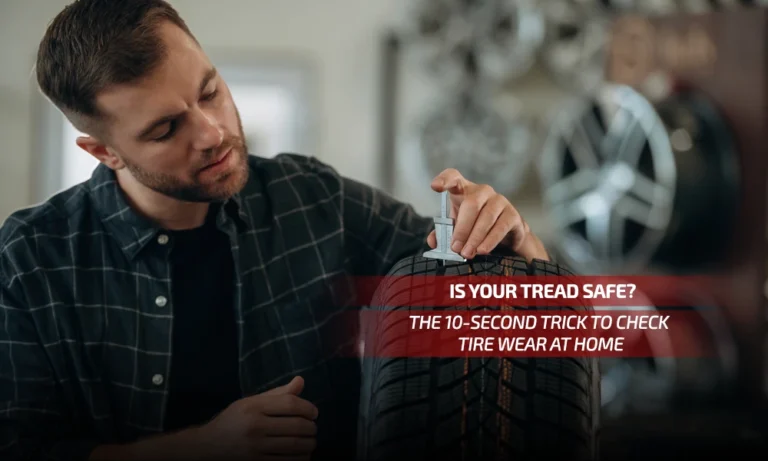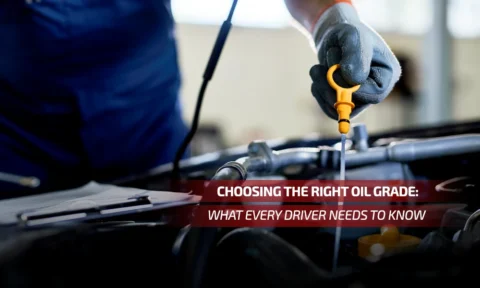Ever glanced at your tired tires and wondered: “Am I still safe?”
Here’s the hard truth—tread depth means the difference between gripping the road and sliding into trouble.
But you don’t need a mechanic or fancy devices. This blog shows you a reliable, 10‑second method to check tire wear in your driveway.
Use this trick before every road trip or school run and know when it’s time to replace your tires—no excuses.
The 10‑Second Penny & Quarter Test
Grab a penny and a quarter. Insert them head-first into your tire’s grooves:
- Penny test: If Abe’s full head is visible, your tread is 2/32″ or lower—legally bald.
- Quarter test: If Washington’s head shows, you’re under 4/32″—time to start shopping for replacements.
Quick, cheap, and so simple—it takes only seconds and keeps you safe.
How many times do I need to check around the tire?
Check 4–5 spots per tire—front/rear and both sides—because uneven wear (like camber or toe issues) can hide bald spots.
Even one low spot means you need new rubber .
Built‑In Wear Bars Do Half the Job
Modern tires include wear bars—raised indicators molded at 2/32″ depth.
Feel for these bands: if they’re flush with the tread, your tires are legally bald and need immediate replacement.
No coins required—just a quick visual check.
Can I trust wear bars instead of coins?
Yes, as long as you inspect multiple grooves. Some tires wear unevenly—if one bar is flush, it’s time to replace all four.
Use a Gauge for a Pinpoint Measurement
Want exact numbers? Grab a $5 tread-depth gauge from a parts store:
- Place the probe in the shallowest groove.
- Push the shoulders flat on the tread.
- Read in 32nds or mm.
This helps you monitor safety levels: 6/32″ is fine, 4/32″ is caution, 3/32″ is near limit, and 2/32″ is bald.
When should I buy a gauge?
Buy one if you care about rainy‑day safety or plan serious driving.
They fit in your glovebox, cost under $10, and give you trusted details beyond a quick coin check.
Why Tread Depth Matters for Safety
Thin tread on a rainy or snowy day is like driving on ice .
Braking distance increases, hydroplaning risk jumps, and road grip plummets.
Even decent tread under 4/32″ can compromise handling—penny tests only pick up the last bit.
Is a tread depth of 4/32″ safe for rain and snow?
Barely. While 2/32″ is legal, 4/32″ offers a buffer for rain and light snow.
If tread measures 4/32″ or less, plan to replace—especially if you live in wet climates.
Inspect Tire Age: Don’t Let Old Rubber Mislead You
Tread isn’t the only factor. Tires degrade over time.
Experts recommend swapping tires older than five years—even if tread is present—because rubber stiffens and cr.
Check the DOT code stamped on the sidewall: the last four digits tell you the week and year made.
My tires look good but are five years old—should I still replace them?
Yes. Time breaks down rubber, making tires unsafe before they wear out.
If you live in hot climates, check annually—even good-looking tread can fail under stress.
Quick Safety Routine: 3 Minutes to Secure Drive
- Walk around the car.
- Use coin & wear-bar signs.
- Visually inspect sidewalls (cracks, bulges, dry rot).
- Optional: gauge depth in problem spots.
- Check DOT code for age.
Do this every month—or before long road trips—and keep your insurance and peace of mind intact.
Your Home Safety Kick‑Start
You don’t need a mechanic to keep your tires safe. Grab change and check your tread in 10 seconds.
Take action before it’s too late—your life and your car depend on it.
Tread tests are simple—but their impact is massive.
Use them, stay alert to tyre age, and never ignore uneven wear.
Do this and you’ll avoid fines, accidents, or costly surprises.






